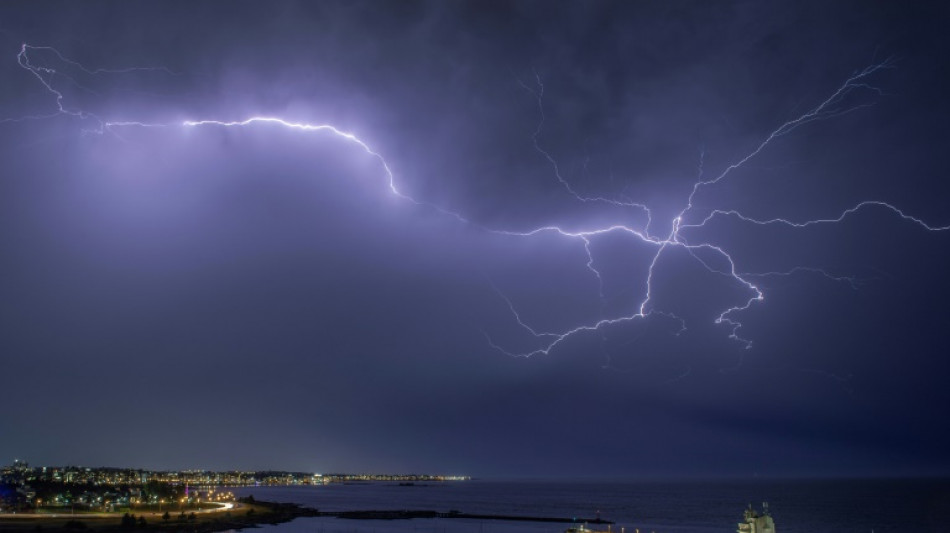
-
 Paris stocks drop as French PM resigns
Paris stocks drop as French PM resigns
-
Death toll from Indonesia school collapse rises to 63

-
 Medicine Nobel to trio who identified immune system's 'security guards'
Medicine Nobel to trio who identified immune system's 'security guards'
-
UN rights council launches probe into violations in Afghanistan

-
 UK author Jilly Cooper dies aged 88
UK author Jilly Cooper dies aged 88
-
Jilly Cooper: Britain's queen of the 'bonkbuster' novel

-
 Streaming stars' Le Mans race scores Twitch viewer record
Streaming stars' Le Mans race scores Twitch viewer record
-
England rugby star Moody 'shocked' by motor neurone disease diagnosis

-
 Leopard captured after wandering into Indonesian hotel
Leopard captured after wandering into Indonesian hotel
-
Israel, Hamas due in Egypt for ceasefire talks

-
 Rescuers scramble to deliver aid after deadly Nepal, India floods
Rescuers scramble to deliver aid after deadly Nepal, India floods
-
Tokyo stocks soar on Takaichi win, Paris sinks as French PM resigns

-
 OpenAI offers more copyright control for Sora 2 videos
OpenAI offers more copyright control for Sora 2 videos
-
Australia prosecutors appeal 'inadequate' sentence for mushroom murderer: media

-
 Rugby World Cup-winning England star Moody has motor neurone disease
Rugby World Cup-winning England star Moody has motor neurone disease
-
Trump says White House to host UFC fight on his 80th birthday

-
 Vast reserves, but little to drink: Tajikistan's water struggles
Vast reserves, but little to drink: Tajikistan's water struggles
-
US government shutdown may last weeks, analysts warn

-
 Arsenal host Lyon to start new Women's Champions League format
Arsenal host Lyon to start new Women's Champions League format
-
Gloves off, Red run, vested interests: Singapore GP talking points

-
 Bills, Eagles lose unbeaten records in day of upsets
Bills, Eagles lose unbeaten records in day of upsets
-
Muller on target as Vancouver thrash San Jose to go joint top

-
 Tokyo soars, yen sinks after Takaichi win on mixed day for Asia
Tokyo soars, yen sinks after Takaichi win on mixed day for Asia
-
China's chip challenge: the race to match US tech

-
 UN rights council to decide on creating Afghanistan probe
UN rights council to decide on creating Afghanistan probe
-
Indonesia sense World Cup chance as Asian qualifying reaches climax

-
 ICC to give war crimes verdict on Sudan militia chief
ICC to give war crimes verdict on Sudan militia chief
-
Matthieu Blazy to step out as Coco's heir in Chanel debut

-
 Only man to appeal in Gisele Pelicot case says not a 'rapist'
Only man to appeal in Gisele Pelicot case says not a 'rapist'
-
Appetite-regulating hormones in focus as first Nobel Prizes fall

-
 Gisele Pelicot: French rape survivor and global icon
Gisele Pelicot: French rape survivor and global icon
-
Negotiators due in Egypt for Gaza talks as Trump urges quick action

-
 'My heart sank': Surging scams roil US job hunters
'My heart sank': Surging scams roil US job hunters
-
Competition heats up to challenge Nvidia's AI chip dominance

-
 UK police to get greater powers to restrict demos
UK police to get greater powers to restrict demos
-
Guerrero grand slam fuels Blue Jays in 13-7 rout of Yankees

-
 Five-try Bayonne stun champions Toulouse to go top in France
Five-try Bayonne stun champions Toulouse to go top in France
-
Fisk reels in Higgo to win maiden PGA Tour title in Mississippi

-
 Aces overpower Mercury for 2-0 lead in WNBA Finals
Aces overpower Mercury for 2-0 lead in WNBA Finals
-
Bayonne stun champions Toulouse to go top in France

-
 Greta Thunberg among Gaza flotilla detainees to leave Israel
Greta Thunberg among Gaza flotilla detainees to leave Israel
-
Atletico draw at Celta Vigo after Lenglet red card

-
 Ethan Mbappe returns to haunt PSG as Lille force draw with Ligue 1 leaders
Ethan Mbappe returns to haunt PSG as Lille force draw with Ligue 1 leaders
-
Hojlund fires Napoli into Serie A lead as AC Milan held at Juve

-
 Vampires, blood and dance: Bollywood horror goes mainstream
Vampires, blood and dance: Bollywood horror goes mainstream
-
Broncos rally snaps Eagles unbeaten record, Ravens slump deepens

-
 Former NFL QB Sanchez charged after allegedly attacking truck driver
Former NFL QB Sanchez charged after allegedly attacking truck driver
-
France unveils new government amid political deadlock

-
 Child's play for Haaland as Man City star strikes again
Child's play for Haaland as Man City star strikes again
-
India crush Pakistan by 88 runs amid handshake snub, umpiring drama


Thunderstorms are a 'boiling pot' of gamma rays, scientists find
Big thunderstorms continuously emit gamma rays that are undetectable from the ground, two studies said on Wednesday, upending what was previously thought -- and potentially pointing towards a clue in the mystery of how lightning is sparked.
Despite the fact that 40,000 thunderstorms generate more than eight million lightning strikes above our heads every day, they "remain poorly understood", physicist Joseph Dwyer said in an analysis of the new research in the journal Nature.
Normally when people think of gamma rays -- bursts of an incredibly high-energy form of light -- they are coming from out of this world, such as solar flares, exploding stars or black holes.
However in the 1990s, NASA satellites tasked with hunting down high-energy particles from such cosmic sources detected gamma rays coming from Earth.
Other than inside nuclear reactors, nothing on our planet had been thought capable of generating gamma rays.
Since then, two different types of gamma rays have been observed inside thunderstorms -- both invisible to the naked eye.
Gamma-ray glows can last for a few minutes over a region roughly 20 kilometres (12 miles) wide, while more powerful "flashes" last less than a millisecond.
"As it turns out, essentially all big thunderstorms generate gamma rays all day long in many different forms," Steven Cummer, a researcher at Duke University and a co-author of one of the studies, said in a statement.
- Bubbling cauldron of gamma rays -
To find out more about what is happening inside thunderstorms, the international team of researchers used an NASA ER-2 airplane.
The scientific aircraft, based the American U-2 spy plane, can fly more than twice as high as a commercial airliner, soaring far above storm clouds.
Over a month in 2023, the plane left a Florida air force based to fly at an altitude of 20 kilometres over active storms, capturing evidence that gamma radiation is much more common than had been thought.
The storms almost continuously generated gamma-ray glows for hours across thousands of square kilometres, all of which were closely linked to the most intense areas of the storm.
The storms resemble "a huge gamma-glowing 'boiling pot' in both pattern and behaviour," said the author of the first Nature study, which was authored by Martino Marisaldi of Norway's University of Bergen.
The second study revealed that glows could intensify into what it called "flickering" gamma-ray flashes. These could be the elusive "missing link" between glows and flashes, it added.
These observations "blur the line between these two types of emission, suggesting that gamma-ray glows often morph into intense pulses", Dwyer explained.
Lightning often follows these intense gamma ray emissions, which suggests they might play some role in sparking lightning strikes, according to the second study.
"How lightning is initiated inside thunderstorms is one of the greatest mysteries in the atmospheric sciences," Dwyer said.
"It is amazing that, more than two decades into the 21st century, Earth's atmosphere has enough surprises in store to motivate an entirely new line of research."
C.Koch--VB

